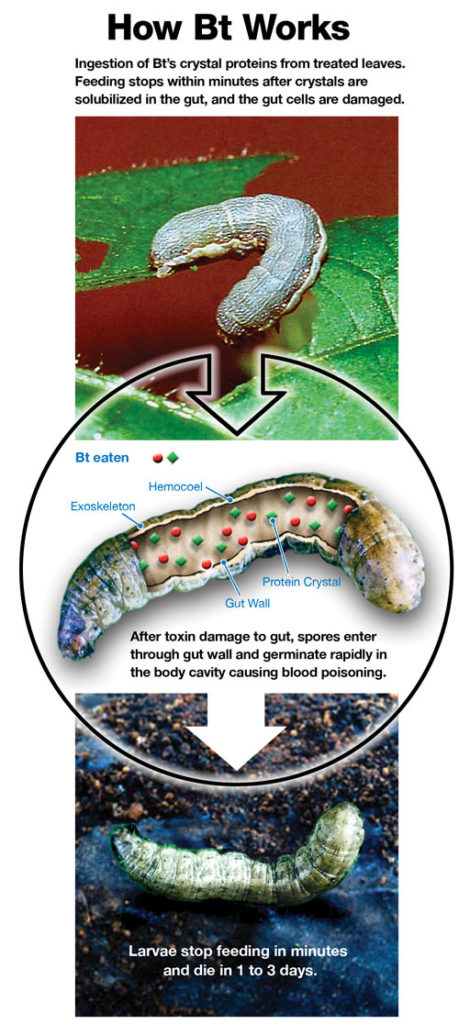Mode of Action
Forest Health Products
Foray Mode Of Action
Foray® is a biological insecticide based on Bacillus thuringiensis subspecies kurstaki (Btk) Strain ABTS-351. Bacillus thuringiensis (Bt) is rod-shaped, spore-forming microorganisms used to control target insects in a manner that is both highly effective and environmentally benign. Bt are naturally-occurring throughout most regions of the world. They are common in soil and on plant leaves and are biodegradable.
VBC’s proprietary Strain ABTS-351 is high yielding strain of Btk that produces a uniquely balanced blend of four Cry toxin proteins – Cry1Aa, Cry1Ab, Cry1Ac, Cry2 – plus Bt spores. Cry toxins are lethal to many pest and disease-carrying insect species, such as caterpillar, beetle, and mosquito larvae. Cry toxins are also harmless to humans, birds, pollinators, and other beneficial wildlife.
Cry toxins act as selective stomach poisons with target insect. Spores contribute to their toxicity by causing blood poisoning and providing environmental persistence.
When an insect pest ingests Cry proteins from treated leaves, its feeding stops within minutes. The protein crystals are solubilized in the gut of the pest and gut cells are irreparably damaged. Once this damage occurs, Bt spores enter through the gut wall and germinate rapidly in the body cavity causing blood poisoning. The larvae then die in 1-3 days.
Affected larvae move slowly, discolor, then shrivel, blacken, and die. Smaller larvae die more quickly, which suggests that precise timing can measurably improve the performance of the application.
Some pest species are can be difficult to control with toxins alone. Foray’s germinating Bt spores provide an additional control mechanism and have a distinct advantage over Bt products without spores.
Mimic Mode of Action
Mimic® is an insect growth regulator from VBC that has a unique mode of action. Mimic induces a premature molt by direct stimulation of the ecdysteroid receptors in susceptible lepidopteran species, ultimately causing death of the caterpillar.
When treated foliage is consumed by the target pest, the active ingredient, tebufenozide, ‘mimics’ the natural hormone (ecdysone) that caterpillars produced to induce a molt. Each molting stage for the pest results in a larger more developed ‘instar. With each molt, the caterpillar must shed its outer cuticle or ‘skin,’ since the cuticle will not expand as the larvae feeds and grows.
Mimic initiates and then accelerates this molting process and produces a new, malformed cuticle under the old cuticle. This prevents the insect from shedding its old cuticle, putting pressure on the larvae and preventing it from feeding and growing. The larvae stop feeding within 24 hours and death follows shortly thereafter.
